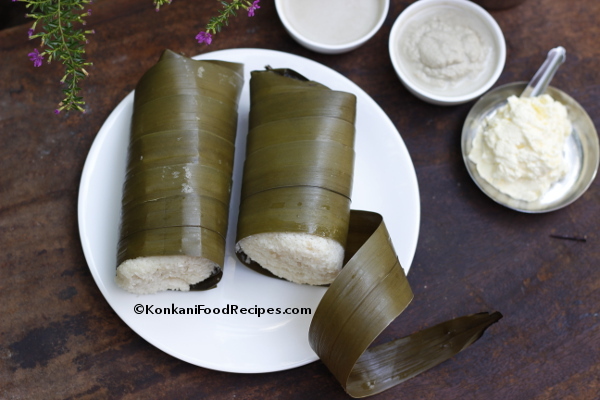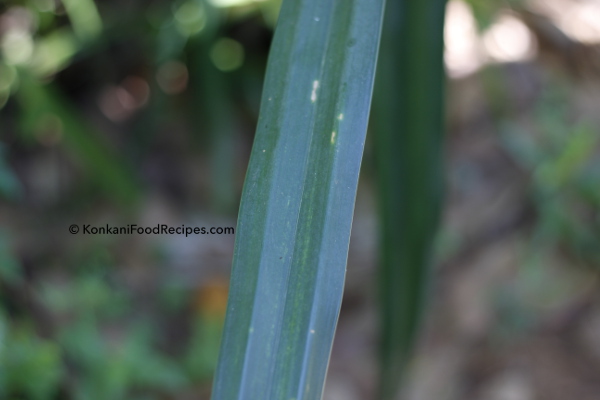Idlis Steamed In Screw Pine Leaves (Moode)

In the beautiful land of Udupi, Mangalore, plain idlis are made special and fragrant by steaming idli batter in jackfruit leaves, banana leaves, pandan/screw pine leaves, turmeric leaves, teak leaves, Macaranga peltata leaves (recipe will be up on the blog soon).
Moode are idlis wrapped up like a mystery in screw pine leaves! A delicacy from Udupi, Mangalore region. The screw pine leaves/pandan leaves add a distinct taste and aroma to idlis and make them special, unique and delicious.
Screw pine leaves are weaved into cylindrical moulds and are used to steam idli batter. They make cylindrical idlis, which are called as ‘moode’ in Kannada/Tulu. They are made during festivals, a must for Krishnajanmastami festival and are served as breakfast during special occasions and celebrations. It also shows up on tables of most Udupi, Mangalorean homes as breakfast every once in a while. People from Udupi and Mangalore have a flair for these cylindrical idlis.
Moode are versatile, they are traditionally had with butter/ghee/coconut oil on top and with coconut chutney's, chicken curries, sprouted green gram coconut based curry, a sweet-sour-spicy pineapple curry etc.
The art lies in making these moulds, which is slowly dying. You then steam your normal idli batter in these cylindrical moulds. Steaming is when the magic happens. The screw pine/pandan leaves impart an amazing taste and aroma to the idlis. And that’s when the heavenly smell of steaming moode, fills up your home.
These days people buy moode moulds from roadside vendors in Udupi, Mangalore as making them involves a lot of work. Thanks to our lovely neighbours, the Madhyasta family, who’s mastered the art of making moode moulds, we got some beautiful moulds. Here’s a video of Geetha Madhyasta, our neighbour, teaching me how to weave a moode.
Ole means leaves in Kannada, mundakka in Kannada is the local name of pandan/screw pine plant, hence moode are also called as mundakana ole, oli kadubu in Kannada in Udupi, they are also called as voli moode in Tulu, mundanoli khotto in Konkani.
Traditionally, Pandanus unipapilatus, the screw pine variety having vicious thorns on the spines and sides of the leaves are used to make moode (the cylindrical moulds). The thorns are neatly scaled, the leaves are then withered in an open flame on the ground (these days on the cooking stove) to remove moisture from the leaf. This makes the leaves less brittle and prevent tearing of the leaves. And thus prevents oozing out of the batter from the moulds, later on while steaming. The withered leaves are then weaved into cylindrical moulds. The screw pine leaves are thick enough to be split into 2 and be used to make moode moulds. Each screw pine leaves are long enough to make 2-3 moode's too.
Natives of Udupi, Mangalore have found a variety of pandan without thorns. These leaves help save time and effort involved in removing the thorns off the screw pine leaves traditionally used (Pandanus unipapilatus). This variety of pandan is called as mundaka in Kannada and also grows easily in backyards unlike the screw pine variety with thorns (Pandanus unipapilatus), which usually grows along side beaches, river banks, ponds of coastal areas. Sorry couldn't find the species the plant belongs to, as the genus Pandanus has over 750 species of plants, commonly called as screw palms, screw pine, pandan. Leaves of these mundaka plants look similar to any other variety of screw pine leaves, impart similar taste and smell to idlis. The leaves in the images below and the leaves used in the video above are that of mundakka, the variety of pandan without thorns widely available in Udupi. The plant, leaves look like these:
These super long leaves (which go upto 60cm) are withered on a cooking stove or in an open flame on the ground and then the leaves are rolled tightly one after the other to keep the long leaves intact in shape untill they are used. These circular rolls made are called as chandrike in Kannada.
If the leaves aren't withered with care then they smell completely of smoke and they may not be very pleasant to eat.
The withered leaves tend to change in colour with time. They brown, so use them while they are fresh for an amazing smell and taste.
Moulds ready to steam idlis in:
My neighbour uses the thorns of Catunaregam spinosa, kaarekaayi gida, maggaare in Kannada, to make these moulds. You can also use dried coconut leaves petioles, dried bamboo sticks to make these moulds.
Each moode can hold a lot of idli batter due to it's elongated shape and 2 moodes can fill you up. :-) Moode filled with idli batter, on the steamer:
Here’s how they look after they are steamed:
The colour of the leaves change on steaming:
Before you serve them, remove all the thorns used to keep the moode moulds intact. Peel open the moode slowly as shown below:
How moode's are weaved you wonder? Watch this.
Ingredients:
- 3/4 cup split black lentil (urad dal)
- 1.5 cups of rice semolina (idli rava, rice rava)
- Salt to taste
- 5-6 moode moulds
Serves: 2-3
Prep Time: 60 minutes, overnight fermentation
Cooking time: 30 minutes
Preparation Method:
- Grind the batter for these idlis on the previous night of preparation.
- And to make a batter, soak urad dal for a minimum of 30 minutes. Wash them well and drain all the water.
- Grind them using as little water as possible into a smooth paste. I suggest using a wet grinder over a blender, for a super smooth batter.
- Transfer the ground batter into a big vessel. Add in rice semolina, salt and mix well. The batter tends to rise on fermentation so use a bigger vessel.
- We need a semi-thick batter and not a very thick batter. The batter should fall off the ladle easily. So, add a little water if required. Be careful not to add excess.
- Keep the batter closed aside and allow it to ferment overnight for a minimum of 7-8 hours on hot days and 10-12 hours during winter. If you live in a cold region look for tips to ferment the batter below.
- Just before you steam these idlis in the morning, give the batter a nice mix as the semolina would have settled down at the bottom of the vessel.
- Get your steamer going and once the water is rolling hot start filling the batter into the screw pine moulds.
- First keep the screw pine moulds into the steamer lined up next to one another.
- Then pour fermented batter into the moulds upto 3/4th of the mould, as the fermented batter tends to rise and fill up the mould. If not they fall out of the mould.
- If your moulds aren't standing straight once they are filled, then place them inside idli moulds/ramekins to prevent them from toppling over.
- Steam them for 30 minutes on a medium flame.
- After steaming, open the lid and put it back on with a little space for the steam to escape. Don't close it fully, to prevent steam from trickling onto the idlis.
- Serve steaming hot moode by peeling the leaves after 5 minutes of steaming. They otherwise tend to break into pieces if you try to peel them soon after steaming.
- Before you serve them, remove all the thorns used to keep the moode moulds intact. Peel open the moode slowly as shown here.
Servings suggestions:
Serve steaming hot mudde with butter/ghee/coconut oil on top and with a spicy coconut chutney or chicken curry or sprouted green gram coconut based curry or a sweet-sour-spicy pineapple curry etc.
Note on fermenting the idli batter if you live in a cold region:
Fermentation needs warm temperatures. So, in summer the batter ferments very well and doubles or triples in it's quantity within a few hours. With drop in temperatures you would have to ferment them for longer.
But in cold places, the batter has to be kept in a warm place for it to ferment. If your oven has light, then turn on the light for a few hours with the batter in the oven. Once the oven is warm, turn off the light and let the batter undergo fermentation.
If your oven does not have a light, then preheat the oven to warm, turn off the oven. Then keep the batter in the oven to ferment.
You would have to experiment and keep a watch to get the right amount of fermented batter depending on the temperature in your place.
More info on Pandan:
Mundaka isn't the flavourful pandan leaf, Pandanus amaryllifolius variety widely used to flavour rice, sweet and savoury dishes. (Called as sannakki in Kannada.) However, the leaves look pretty similar, the only difference being, the mundakka used to make the above moulds have a thick, broad, dark green, leathery textured, long leaves unlike the flavourful, thin, not so long, pandan leaves below: Pandanus amaryllifolius leaf, sannakki leaf:
Pandanus amaryllifolius plant, sannakki plant:
More Info on Pandanus amaryllifolius: http://theepicentre.com/spice/pandan-leaf/, http://www.cooksinfo.com/screw-pine-leaves.
They are also different from the fragrant screw pine - Pandanus odorifer - http://www.itslife.in/gardening/wild-plant-and-flowers/kewda-tree
Find more Konkani cuisine, Udupi, Mangalorean breakfast recipes here.
Moode is a must make breakfast for Krishna Janmastami in most Udupi homes.
Tags: kedige leaves, screw pine leaves, pandan leaves, moode, mooday, kadubu, kottige, mundakana ole kadubu, oli kadubu, Idlis steamed in screw pine leaves, Udupi cuisine, Mangalorean food, Ashtami, Krishna janmastami


















Tweet